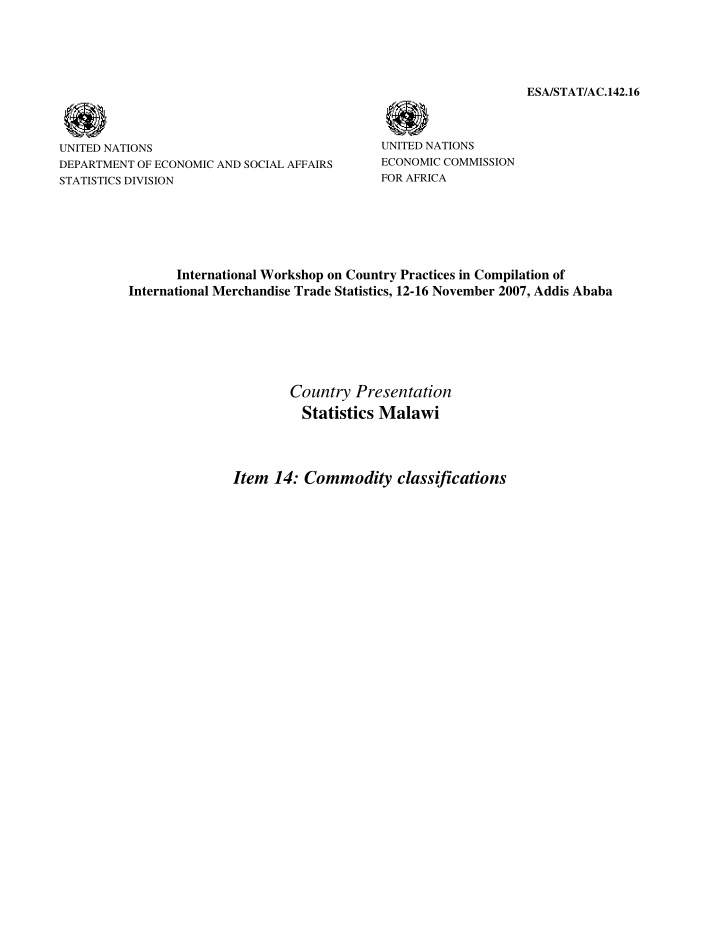



ESA/STAT/AC.142.16 UNITED NATIONS UNITED NATIONS ECONOMIC COMMISSION DEPARTMENT OF ECONOMIC AND SOCIAL AFFAIRS FOR AFRICA STATISTICS DIVISION International Workshop on Country Practices in Compilation of International Merchandise Trade Statistics, 12-16 November 2007, Addis Ababa Country Presentation Statistics Malawi Item 14: Commodity classifications
COMMODITY CLASSIFICATION & QUANTITY MEASUREMENT BRIGHT CHIPUTA MVULA TRADE STATISTICIAN (MALAWI) CONTENTS OF THE PRESENTATION 1. Classifications used in disseminating trade statistics. 2. Quantity Measurements used by Customs. 3. Aggregation of information on Quantity. 4. Problems experienced on Quantity & Value information from Customs Data. 5. Data Sources. 6. Quality Control. 7. Areas of special consideration 1
CLASSIFICATIONS FOR DISSEMINATING TRADE STATS There are three classifications of commodities which � we follow during data analysis i.e. a) HS – Classification of goods according to their physical material nature (97 categories/tariff lines). b) SITC Rev. 3 – UN classification of goods for statistical purposes. It also groups commodities by level of processing (10 Categories). c) BEC-Classifies goods according to end use (7 categories). QUANTITY MEASUREMENTS USED BY CUSTOMS The following are the quantity measurements of some commodities used by Customs: a) Kilograms - Tobacco ( HS Code 2401) is measured in kgs. b) Pairs - Footwear ( HS Code 6401) are measured in pairs. c) Units/ Numbers - Tractors ( HS Code 8701) are measured in units. d) Litres - Water ( HS Code 2201) is measured in litres. e) Square Metres –Carpets ( HS Code 5701) are measured in square metres. f) Cubic Metres -Plywood ( HS Code 4412) is measured in cubic metres. g) Kilowatts -Electricity ( HS Code 2716) is measured in kilowatts. 2
Aggregation of Quantity information Quantities are aggregated by commodity code. a) For example, all goods imported from different countries all over the world but having the same HS code are grouped together. This is done automatically during data extraction once the data is available in the computer (EUROTRACE PACKAGE). b) Again, if new data set is added to the old one, the data banks are updated. This in turn automatically changes quantities and values already available in the computer. SEE THE TABLE ON THE NEXT SLIDE FOR ILLUSTRATIONS IMPORTS(HS) BY QTY AND VALUE IN MALAWI KWACHA 3
Problems associated with quantity and value information from customs data. These are some of the problems: a) A car could be measured in tonnes/kgs instead of unit (number). This makes the unit price very small. b) Misclassification of codes-For example, diesel is recorded as petrol and viceversa.This in turn causes underestimation/overestimation of quantities for different commodities. c) Omission of quantity data for some commodities. d) Writing wrong commodity codes. This delays data processing since the data is sent back to MRA for corrections. e) Supplementary units are not provided on some forms. DATA SOURCES It is essential to start with data sources before we start looking at quality control as we shall see later: Data is submitted to NSO on the 15 th of every month for the previous � month by Malawi Revenue Authority (MRA). This is done through hard copies and soft copies (flash disks, CDs & e-mail). However, there are some delays in data submission which entail follow-ups. Major exporting companies e.g. Sugar Corporation � Electricity Supply Commission of Malawi (ESCOM) � Some MRA offices capture electronic data in ASYCUDA+ + . Once this � data reaches the National Statistical Office, it is loaded into the server and it is later converted and stored in the EUROTRACE PACKAGE. 4
QUALITY CONTROL � To ensure quality control, a) goods included in our analysis are: all traded goods from the Customs Declaration Forms. b) For significant results, only goods valued at 1,000 Malawi Kwacha and above are included in our analysis. QUALITY CONTROL CONTINUED… Goods excluded in analysis are: • a) consignment of goods in direct transit. b) returned merchandise and returned material. c) merchandise repair free of charge. d) personal belongings; removable articles imported on transfer of residences. e) goods imported by diplomatic corps. f) supplies under military defence agreements. g) Commercial samples. 5
QUALITY CONTROL CONTNUED… � Hard copies from Non automated customs offices undergo 1. Sorting 2. Manual Checks 3. Verification of Codes 4. Wrong and late entries are identified. The Bills of Entry are sent back to MRA for physical verification. 5. Data entry. QUALITY CONTROL CONTINUED… Quality control of electronic data from Automated Customs office involves: a) Checking of codes e.g. HS,partner country etc. b) The relationship that exists between net weight and supplement unit (pieces). c) The checks are built up in the validation rules of the EUROTRACE. For example, “Quantity must be supplied” indicates that this value was mistakenly left out. 6
AREAS OF SPECIAL CONSIDERATION � INDICES. � DISSEMINATING INFORMATION. � FREQUENT MEETINGS FOR UPDATE OF INFORMATION. <<<THANK YOU FOR YOUR ATTENTION>>>!!!!! <<<THANK YOU FOR YOUR ATTENTION>>>!!!!! 7
Recommend
More recommend